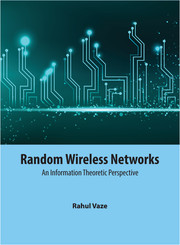Book contents
- Frontmatter
- Dedication
- Contents
- List of Figures
- Preface
- Acknowledgments
- Notation
- 1 Introduction
- 2 Transmission Capacity of ad hoc Networks
- 3 Multiple Antennas
- 4 Two-Way Networks
- 5 Performance Analysis of Cellular Networks
- 6 Delay Normalized Transmission Capacity
- 7 Percolation Theory
- 8 Percolation and Connectivity in Wireless Networks
- 9 Throughput Capacity
- Index
- References
7 - Percolation Theory
Published online by Cambridge University Press: 05 May 2015
- Frontmatter
- Dedication
- Contents
- List of Figures
- Preface
- Acknowledgments
- Notation
- 1 Introduction
- 2 Transmission Capacity of ad hoc Networks
- 3 Multiple Antennas
- 4 Two-Way Networks
- 5 Performance Analysis of Cellular Networks
- 6 Delay Normalized Transmission Capacity
- 7 Percolation Theory
- 8 Percolation and Connectivity in Wireless Networks
- 9 Throughput Capacity
- Index
- References
Summary
Introduction
Percolation theory studies the phenomenon of formation of unbounded connected clusters in large graphs, and percolation is defined as the event that there exists an unbounded connected component in a graph. Any wireless network can be naturally thought of as a graph, where the presence of an edge/connection between any two nodes can be defined in variety of ways. Percolation in a wireless network corresponds to having long-range connectivity, that is, nodes that are far apart in space have a connected path between them.
The objective of this chapter and the next is two-fold: study percolation properties of wireless networks and lay sufficient background required for deriving the throughput capacity of wireless networks in Chapter 9.
In this chapter, we begin by introducing basics of discrete and continuum percolation. We first consider discrete percolation over square lattice, where each edge of the square lattice is assumed to be open or closed independently of each other with probability po and 1 − po, respectively. We show that there is a phase transition at po = pc, such that for po > pc (po < pc), the probability of percolation in non-zero (zero), and find non-trivial bounds for pc. The techniques presented to derive bounds on pc are also helpful for obtaining percolation results for wireless networks, and finding throughput capacity of wireless networks in Chapter 9. We also state results for the discrete face percolation over a hexagonal lattice that are relevant for finding percolation regimes of wireless networks.
Next, to model a wireless communication network, we consider continuum percolation, where node locations are drawn from a spatial distribution, and connections are defined appropriately. First, we study the percolation properties of the most popular Gilbert's disc model, where two nodes are connected if they are within a fixed distance (radio range) r from each other, inspired by point-to-point wireless communication under a path-loss model.
- Type
- Chapter
- Information
- Random Wireless NetworksAn Information Theoretic Perspective, pp. 146 - 175Publisher: Cambridge University PressPrint publication year: 2015



